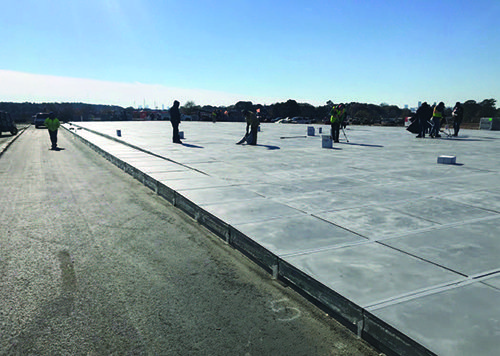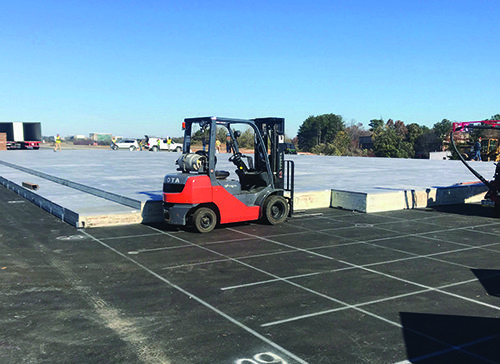The recently completed engineered materials arresting system (EMAS) at DeKalb-Peachtree Airport (PDK) is significant because it provides Atlanta’s primary airport for business aircraft with an FAA-compliant runway safety zone. As one of the last U.S. installations by the system manufacturer, the project also has industrywide implications.
The recently completed engineered materials arresting system (EMAS) at DeKalb-Peachtree Airport (PDK) is significant because it provides Atlanta’s primary airport for business aircraft with an FAA-compliant runway safety zone. As one of the last U.S. installations by the system manufacturer, the project also has industrywide implications.
 Until fall 2020, no other FAA-approved EMAS will be sold in the U.S.; and the system that will be available then is not currently eligible for FAA funding.
Until fall 2020, no other FAA-approved EMAS will be sold in the U.S.; and the system that will be available then is not currently eligible for FAA funding.
Zodiac Aerospace, the French company that supplied the EMAS bed installed at PDK (and more than 100 others at nearly 70 U.S. airports), is no longer selling its system in the U.S. The company announced the change in February 2018, when it merged with Safran, another French aerospace firm. Per an agreement with Zodiac related to a patent infringement lawsuit, the Swedish firm Runway Safe will not begin selling its EMAS beds in the U.S. until September 2020.
|
facts&figures Project: Engineered Materials Arresting Bed Location: DeKalb-Peachtree Airport Owner: DeKalb County, GA Cost: $8 million for runway safety zone; $2.5 million for EMAS bed Funding: 90% federal, 5% state, 5% airport Construction: July 2017-Dec. 2018 Final Grading: April 2019 EMAS Manufacturer: Zodiac Aerospace General Contractor: Astra Group Project Engineer: Michael Baker Int’l Drainage Engineer: Aulick Engineering EMAS Block Installation: Boland’s North Inc. Electrical: Trinity Electrical Asphalt: Stewart Brothers Retaining Wall Installation: Bonn-J Erosion Control: Watkins Environmental Grooving: SE Grinding Concrete: IP, LLC |
The changes put domestic airports needing EMAS in a tough position. “I don’t know of any other systems that would meet the requirements of both being produced in the U.S. and also one that has passed the testing required by the FAA,” explains Joseph Snyder, the Michael Baker International engineer in charge of PDK’s project. “It’s a difficult process to maneuver.”
Although Zodiac is a French company, its systems were manufactured in the U.S. Runway Safe’s EMAS bed is FAA-approved, but is not currently available in the U.S. and is not eligible for FAA funding because it is not manufactured in the U.S. Thus far, Chicago Midway International is the only U.S. airport to install the Swedish system. It installed four Runway Safe EMAS beds from 2014 to 2016.
Both Zodiac and Runway Safe systems use crushable material to stop aircraft during a runway overrun. As an aircraft enters the EMAS bed, its tires sink into the lightweight material, causing the plane to decelerate and eventually stop. Zodiac arrestor beds use crushable cellular cement material to slow the forward movement; Runway Safe beds are made of foamed silica aggregate made from recycled glass.
Materials from both systems that are damaged during an overrun can be removed and replaced with new materials. Safran says it will continue to manufacture replacement blocks for existing Zodiac EMAS beds at the company’s plant in New Jersey.
Accelerated Improvement
The active catalyst for PDK’s $8 million runway safety area project occurred in 2012, when a Beechcraft jet overran the main runway, rolled down an embankment and pierced a fence along the airport property line. The fence prevented the plane from entering a public roadway that runs along the airfield, notes Airport Director Mario A. Evans.
 Airport officials had been discussing runway safety zone improvements with the FAA since 2010, but the 2012 incident put PDK at the top of the priority list, explains Evans.
Airport officials had been discussing runway safety zone improvements with the FAA since 2010, but the 2012 incident put PDK at the top of the priority list, explains Evans.
Runway 21L is 6,001 feet long with an additional 1,000-foot displaced threshold, but it previously lacked a 1,000-foot long safety area, per FAA requirements. In addition, the FAA air traffic control localizer array was located within the already short safety area.
“Prior to construction, they were never able to use the full 5,001 feet,” Snyder explains. “They were short on the safety area by 400 feet, thus the available runway was never more than 4,600 feet for landing operations.”
Planning for the project took five years. During that time, designers also explored relocating the roadway to create the needed safety zone. When plans for a runway extension and EMAS installation prevailed, the team considered systems from Zodiac and Runway Safe.
“We did our homework in looking at other EMAS beds across the country,” Evans recalls. “We even visited one in Greenville, SC. Their drop is even greater than others.”

According to FAA data, the Zodiac system has performed successfully in 15 incidents. In all cases, aircraft were stopped within the safety zone, and no passengers were injured.
The new $8 million runway safety area at PDK includes 250 feet of pavement at the end of the runway and 350 more feet of EMAS bed. The federal government paid 90%, while the state and airport each contributed 5%.
The arrestor bed, which cost $2.5 million, consists of 1,746 blocks that range in depth from 4 inches to 16 inches. The bed was designed for the weight of the average business jet that uses the airport—such as Gulfstream IV and V series aircraft. However, PDK’s runway can handle larger Bombardier Global Express and Gulfstream 650 aircraft.
Work Delays
Construction began in July 2017 and was expected to end in February 2018; but unusually rainy weather and an unexpected site issue caused considerable delays. The bulk of the project wasn’t completed until December 2018, with final grading outside of the safety area still underway this April.
Preparatory projects included relocating storm and sanitary sewer lines, the FAA fiber optic lines that are part of the airport’s navigation lighting system and the FAA localizer.
Preliminary site work required crews to truck in 80,000 cubic yards of soil to raise the grade of the safety area. A 30-foot retaining wall was installed at the end of the runway and along airport property to hold back the new grade. The wall was needed to keep soil and water from flowing through a cemetery located directly adjacent to the airport property and safety area.
Frequent rain made it difficult to move and compact the soil. (2018 was the second-wettest in Atlanta since the 1950s). For each day of rain, it took three days for the soil to dry, Snyder notes.
As dirt was being moved in the safety area, crews discovered an active 60-inch storm sewer line that wasn’t depicted on the site plans or previous as-builts. It took three months to design a new line to connect into the storm sewer network, build it 40 feet beneath the new grade and install a new manhole.

Crews worked at night to shape the safety area so the runway could remain active. In the last 60 days, daytime limitations were imposed on aircraft operations.
In the first 30 days, Runway 21L was limited to departures only except at night. In the final 30 days, the runway was open for both departures and arrivals, but the available landing distance was limited to 4,551 feet.
Overall, PDK had 151,132 operations in 2018. Of those, fully 110,000 were from transient business jets. Local traffic is primarily piston aircraft.
The airport maintains tie-down spots and 153 T-hangars for about 410 aircraft that are based at PDK Based aircraft are about evenly split between business jets and piston pleasure crafts.
EMAS Update
|
For more information about engineered materials arresting systems, go to https://www.faa.gov/news/fact_sheets/news_story.cfm?newsid=13754



